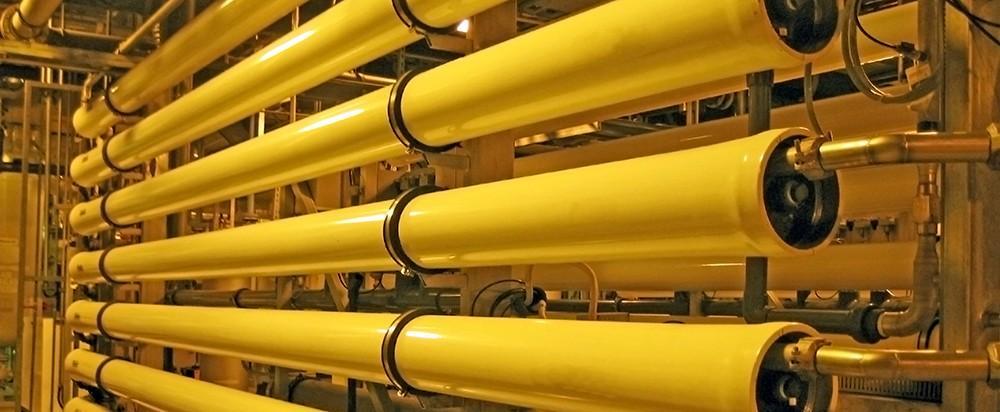02/08/2022 | Industrial Water Treatment | 8 MINUTE READ
The Process of Ion Exchange and its Industrial Applications

Among the most effective water treatments that can be used to rid water of contaminants is the ion exchange process. Ion exchange involves removing certain contaminants from water by essentially exchanging the contaminant with an ionic substance that’s considerably safer. The exchanged substance and contaminant will both need to consist of the same electrical charge and will need to dissolve in water for the process to work as intended.
An example of the ion exchange process involves another process that’s known as water softening. The purpose of water softening is to effectively reduce the amount of magnesium and calcium content in the water. However, ion exchange can also be used for the removal of toxic metals from water.
Because of the effectiveness of the ion exchange method, this water purification technique has many industrial applications, which include everything from metal finishing applications to food and beverage production. This article provides you with a more detailed explanation on the ion exchange process and the many industrial applications it’s used for.
Ion Exchange Industrial Applications
The ion exchange process is commonly used throughout numerous industrial applications because of the many benefits that this process provides. The main industrial applications that ion exchange has include:
- Purified water for power engineering
- Soft water production for soaps and laundry detergents
- Metals finishing
- Food and beverage production
- Sugar production
- Pharmaceutical technology
- Industrial water treatment
- Hydro-metallurgy
- Semiconductor applications
- Potable water treatment
One standard ion exchange application involves preparing high-purity water that can be used for nuclear, power engineering, and electronic industries. Inorganic insoluble or polymeric ion exchangers are typically used for water purification, water softening, and water decontamination purposes. Many household filters are based on the ion exchange process and work by producing soft water. The soft water that’s produced from these filters is effective when used in a water heater or when paired with a laundry detergent.
It’s possible for water to be softened via the ion exchange process when divalent cations like magnesium and calcium are exchanged with monovalent cations that are highly soluble. The ion exchange process is also regularly used for domestic water treatment via the removal of natural organic matter and nitrate from water.
While the ion exchange process is common for water treatment purposes, it also has other industrial applications that don’t necessarily involve water treatment. For instance, ion exchange is necessary for the extraction of plutonium and uranium. With this process, it’s possible to separate the uranium and plutonium from other actinides like neptunium, americium, and thorium. Lanthanides can also be separated from one another with the ion exchange process.
It’s possible to use ion exchange to get rid of hardness in water by exchanging magnesium and calcium ions that create hardness for sodium ions. Some additional industrial applications include:
- Production of chemically strengthened glass
- Dealkalization
- Cation-exchange capacity for soil science applications
- Planar waveguide manufacturing
- Geotechnical engineering and pollution remediation
Before using a water treatment system that’s outfitted with ion exchange technology, it’s common to test the makeup of water to determine how much treatment is necessary. While several different types of sensors can be used to test any sample of water, the main sensors that could help you during this process are pH sensors. The pH of water can range from 0-14. Any measurement below 7.0 is considered to be acidic. All measurements above 7.0 are believed to be alkaline.
The exact composition of water that you’re looking for depends on the type of application that the water is being used for. While alkaline water is generally believed to have less contaminants than acidic water, an alkaline solution may contain high levels of magnesium and calcium, which can lead to the development of hard water. This type of water can cause scale buildup in piping and other industrial equipment, which is when the ion exchange process can be used to soften the water.
On the other hand, acidic water usually occurs when high concentrations of contaminants like copper and iron are present in the water. These contaminants can be unhealthy to consume and may even make the water smell bad. If you’re trying to achieve a more neutral pH balance, you should first test the water to identify what the current pH levels are. The readings you obtain can then inform the remaining ion exchange and water treatment process that occurs.

Advantages and Disadvantages of Ion Exchange in Industrial Applications
There are many advantages and disadvantages of using the ion exchange process in industrial applications. Understanding what these pros/cons are should help you identify if this technique is right for you and the application you would like to use it for.
Advantages of Ion Exchange
The primary advantages of the ion exchange process include:
- Can regenerate the resin that’s used
- Initial investment is considerably more affordable than other water treatment methods
- Is extremely effective at removing inorganic ions from water
Disadvantages of Ion Exchange
There are also several disadvantages to take into account, which include:
- Long-term costs are high when it comes to operating ion exchange equipment
- Unable to effectively remove bacteria from water
- While ion exchange beds can be regenerated, salt water is sent directly into the environment during this process
The Ion Exchange Process
In order for the ion exchange process to occur, the equipment must contain a micro-porous exchange resin. This resin is saturated with a solution that’s very loosely held. When the process is being used for water softening purposes, sulfonated polystyrene beds are placed within the unit. These beds are saturated with a sodium solution that covers the surface of the bed. When water is passed through the resin bed, the ions will attach directly to the beads, which releases the aforementioned solution into the sample water.
Over time, the beds will become saturated with contaminants, which is when the exchange resin will need to be recharged or regenerated. In order to complete the regeneration process, it’s important that a salt brine solution is used to flush the exchange resin. The salt brine solution consists of sodium ions. These ions will replace the contaminants that coat the resin bed, after which the contaminants will be flushed out with all of the wastewater. Because of how the ion exchange process works, it can be used to soften hard water that contains high levels of magnesium and calcium while also being used for the water treatment process.
Cation, Anion, and Amphoteric Exchanges
The three types of ion exchanges that can occur during the ion exchange process include cation, anion, and amphoteric exchanges. The type that you use largely depends on what application the exchange is being applied to. Cation exchanges are designed to exchange ions that are positively charged. These ions are known as cations. Anion exchanges occur when any negatively charged ions are exchanged. These ions are referred to as anions. As for amphoteric exchanges, these exchanges involve the exchange of anions and cations simultaneously.
When anions and cations are being exchanged simultaneously, this process usually occurs in mixed resin beds. However, the solution can also be passed through several ion exchange materials. One example of an amphoteric exchange is when electrolytes need to be separated from non-electrolytes.
Ion Exchange Resins
Ion exchange resins can either be synthetic or produced industrially. These resins are comprised of tiny, micro-porous beads that are known to be insoluble in organic solvents and water. The primary materials that make up these resins are polyacrylate and polystyrene. In most cases, the bead diameter will range from 0.3-1.3 millimeters. These beads consist of 50% water and have a gel-like texture to them.
Because water is sent through these beads, it’s possible for water to move in and out of the beads without issue. The ions within resin beads can either be negatively charged or positively charged. Positively charged contaminants in the water will interact with the negatively charged anions. On the other hand, negatively charged contaminants can interact with the positively charged cations on the resin beads. It’s possible to reverse this process as well.
The purpose of resin beads in water treatment is to capture the contaminants in the water. Whether you’re trying to soften hard water or get rid of contaminants and pollutants in acidic water, the ion exchange process can be beneficial.

Ion Exchange Considerations
The ion exchange process has been used for many years throughout industrial facilities of all types. Whenever water needs to be treated, the ion exchange process has proven to be effective at getting rid of most contaminants. Like most water treatment solutions, there are positives and negatives that come with using the ion exchange method. One positive is that the resin you use can be regenerated. One issue with ion exchange is that the long-term costs of operating an ion exchange system can be high.
If you’re thinking about using this process, there are several factors that you might want to take into account. The costs associated with using ion exchange can differ depending on region and scale. Maintenance requirements should also be factored into your decision. For instance, the regeneration process will create a considerable amount of wastewater, which itself will need to be treated before you reuse or dispose of it. If your main goal is to get rid of dissolved inorganic contaminants from water, the ion exchange process can be highly effective. Finally, be sure to monitor the status of your ion exchange system with reliable conductivity sensors.
Posted by Sensorex on February 8, 2022
Sensorex is a global leader in the design and manufacture of quality sensors for water quality and process applications. The company offers more than 2000 sensor packages for pH, ORP, conductivity, dissolved oxygen, free chlorine, chlorine dioxide, UV transmittance and other specialty measurements, as well as a full line of sensor accessories and transmitters. Its expert technical support engineers solve analytical sensor challenges with custom designs and off the shelf products.




